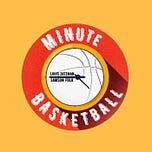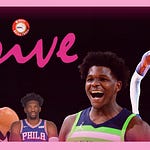Like most everyone else in the world, I was first introduced to the phrase, ‘too big to fail’ in 2008. When people who play self-important video games and huff cocaine for a living robbed the entire world and got away with it. Were thanked. Took their million-dollar bonuses while millions lost their homes.
To say the event radicalized me is true and not. Not, in that I’m not a radical. True, in that I’ve never been an optimist again, not about the big stuff. I retain optimism at the personal level. The Lehmann brothers can’t rob me of that, too, at least not yet. But when I went to university, my Mom moved to where her living room window overlooked Victoria Park, where Occupy Halifax was evicted on Remembrance Day, 2011. The insidious tendrils of capital are long indeed.
And the banks got bigger as a result: too big to fail. An actual legislated fact, otherwise known as Systemically Important Financial Institutions.
The NBA has its Systemically Important Franchise-Institutions, too. The Lakers, as much as AIG, are too big to fail. Even their losses become their wins, given time.
So too are some players too big to fail. Joel Embiid is the Redwood of the NBA, 240 million years of evolution packed into a frame that doesn’t stop flying up. At that size, failure is relative.
This week in Minute Basketball: Too big to fail.
Folk - Purple and Gold, Baby
It wouldn’t be news to anyone for me to suggest that geography plays as big a role in the NBA as organizational competence. This phrase has been uttered millions of times, but: LeBron James joined an organization that couldn’t stop failing despite it’s inherent advantages - and the failing stopped once James was there. Compare that to teams like the Grizzlies, Raptors, or the Nuggets who could never expect to have a mega-star show up at their door by any means other than the draft. Nikola Jokic, Kyle Lowry, and Marc Gasol walked into basketball landscapes that were so barren they demanded men become legends. Forget your perceived reference point, they’ve become the reference point.
Paired with Kawhi Leonard, Pascal Siakam, and a host of other talented players - Gasol and Lowry did reach the mountaintop. Of course, the next season, James and Anthony Davis dominated in their own way in the regular season, and then in every way once the teams embarked for the Bubble. Opportunity emerged for a single postseason - sandwiched in between the dynastic Warriors and the impending duo of Davis and James, who could very well be dynastic as well - and local heroes Gasol & Lowry were granted the opportunity to ingratiate themselves to a wider base, as world champions. The Grizzlies and their fans celebrated the Raptors championship in their own way, knowing that someone they loved had reached the highest peak of their profession.
The Grizzlies and the Raptors can both look back on this past decade of basketball and rest easy knowing smart, shrewd basketball moves were made. Consistent attempts to build out the back end of a roster to make up for the fact that they couldn’t get the top end that was afforded to more luxurious franchises. The Raptors, obviously, lucky enough to get an opportunity to trade for Leonard and all the careful building, and drafting allowed for Leonard to walk into a set culture with a strong identity and dominate in his own way. When James joined the Lakers, without any cost to the franchise because he joined as a free agent and not via trade, the team was in disarray. One lost year later, and Davis joined the team via trade - a big package for what it’s worth - largely because of his desire to play with James, who wanted to play for the Lakers.
So, who is too big to fail? James or the Lakers? James has won a championship with three different franchises in the past decade and the consensus seems to be that he overrides the framework that he arrives at, good or bad. The Lakers struggled immensely in the years between their championships. Memes were made out of their front office, along with six straight years of under .500 basketball. However, James will retire eventually and the Lakers will assume his legacy into their own as a means to recruit all the greatest players of the new eras. And after all, James will never meet the type of incompetency that is couched into ‘too big to fail’ because he’s only ever succeeded on his merits. Even though the Lakers have turned the corner (and had a great offseason recently) they will continue to succeed whether they make good decisions or bad ones.
Liberté, égalité, fraternité, ou la mort! Friendo.
Zatzman - Joel Embiid, MVP
Joel Embiid is Frankenstein’s monster of big men. He has absorbed rips and chunks of NBA stars from years past. Embiid’s quickness is reminiscent of David Robinson, his footwork Hakeem Olajuwon, his jumper Yao Ming.
And oh man his size. Embiid’s size is Shaqian -- Shaq did have some 20-40 pounds on Embiid, depending on the year -- but less in terms of weight and more in relative mass compared to his peers. No one in the NBA has the size to bang with Embiid and come out alive on the other end.
Put all those skills together, and Embiid would probably dust a center like Shaq in a game of 1s. He’s big enough to hang and too skilled to contain. Teleport Embiid back 20 years, 40 years, and most opposing centers would drop dead just to see someone like Embiid doing the things he does on the court.
Offensively, the Sixers sometimes play an entirely different game from the rest of the NBA. They run league-low pick-and-rolls, though Embiid is more than capable there. They subsist almost entirely on ‘outdated’ postups. Why? Because Embiid alone makes them worth using, again and again, until opponents submit, battered and bruised and beaten. Leave him alone, and like centers of days gone by, Embiid will score with ease. Send a double, and he has become a fantastic passer, shredding defenses as they rotate.
Embiid is too big and strong and fast to fail. He is a star purely on the basis of his physical attributes, which are almost unrivaled in the NBA. Against the eventual champion Toronto Raptors in 2018-19, Embiid won his 237 minutes by 90 points, and the Sixers lost the other 99 minutes by 109 points. The Sixers, of course, lost the series in seven games.
Now Embiid is an MVP frontrunner. His impact this season has been as gargantuan as he is. When he plays, the Sixers are better by an outrageous 20.7 points per 100 possessions, which is the single best mark in the league, per Cleaning the Glass.
Of course, NBA big men can break down, no matter their size. As a matter of fact, it happens all the time. Sometimes because of their size. Greg Oden, Andrew Bynum, Sam Bowie. Human knees shouldn’t survive such weight pounding up and down on the ground, again and again. Sometimes they don’t. The superhighway of the NBA is built on the bones of fallen bigs.
After 2008, the United States government’s response was to allow banks and financial institutions to buy each other, to grow. As if they simply weren’t big enough before, as if that was the problem. In the NBA, big men keep on growing. Joel Embiid may be the greatest big in all the land today, but Bam Adebayo is hot on his heels for tomorrow, and Zion Williamson is coming for them all.
In truth, there’s no such thing as too big to fail. In life or in basketball.














Share this post